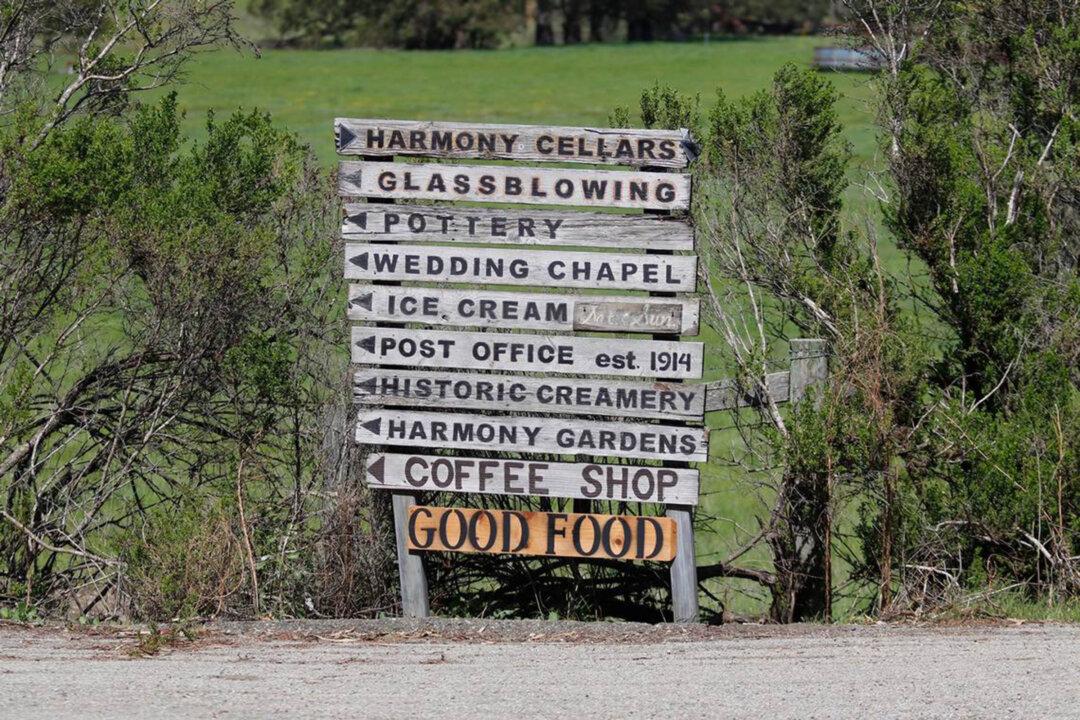Don’t blink as you pass the short, steep turnoff just beyond the second sign, the one with the arrow that points you down the hill to Old Creamery Road in the former dairying village’s one-block district.
Yes, one block. It’s worth the stop.

There also are other more recent additions to Harmony.

As Mike Rice, the winery’s sales manager told The Tribune recently, “You really can’t have a bad day when you work in Harmony.”
The same is true when you visit.
Town Brings Quirky Flavor to North Coast
The offbeat town’s website boasts, “Be it a toilet-seat shrine to a star of the silver screen, a blue door more famous than most people, or our one and only fire truck mysteriously ending up on a rooftop in L.A., we’ve never exactly been on a first-name basis with ‘normal.’”How about this? For decades, the highway sign just before the turnoff read “Harmony Pop 18 Elev 175.”
Is the mini-town’s population still really 18—as locals have claimed for so long—or was it ever?
Nobody knows for sure, despite the original sign installed by Caltrans in 1974 and replaced numerous times, according to historian Debbie Soto’s “Living in Harmony” book.

But locals will tell you with tongue firmly in cheek, “We don’t want to change the T-shirts.”
That population sign is in the middle of downtown now, backdropping a gaily painted, life-sized statue of a cow.
And no, you’re not imagining that there’s another bovine sculpture, an all-white cow, on top of the old Creamery building’s roof.
Eccentric enough yet?
How about this: George Mayer, who owned Harmony from 1977 to 1980, sponsored a legendary “Doo Dah” parade, which had nowhere to go in the one-block town, so watchers walked around the parade.
And don’t forget the cherished grave site of the town’s longtime mayor, Freddy Cheenie Alfredo—Freddy for short.
He was a much-loved and cherished Maine Coon cat. The sociable town mascot lived his entire nine lives in Harmony, passing in 1995 at the ripe old age of 22.
How did Harmony Get Its Start?
Perhaps some of that whimsy comes from Harmony’s lengthy history of cows, cheese, butter, and lots of dairymen and ranchers.According to various historians, the Swiss Italians founded the creamery there in 1869.

The iconic building that’s now the town’s wedding chapel was built with thick stone walls to store dairy products and other perishables. In the ‘70s, the chapel also was used as a wine and cheese shop.
The historic creamery building also housed a rustic, circa 1914 rural post office and, for a time, a small general store where children could buy an ice cream bar for a nickel. The postal service closed the office in 2008.
Harmony town has had several owners through the decades. Paul Fields and Ralph Casper, local cabinetmakers, bought the veritable ghost town in 1970. They spent three years getting the commercial zoning and permits needed to restore the neglected town, Soto wrote.
Part of the creamery structure used to be where Dillow’s Harmony Pasta Factory restaurant was.
That part has been vacant for some time, and it’s likely to stay that way, at least for the foreseeable future, according to town owner Alan Vander Horst.
He said March 31 that it would require a lot of time, work, and money to bring the structure up to code before it could house businesses, especially a restaurant.
Businesses Settled in, like Harmony Pottery Works
Do a fast-forward from creamery days to 1973, when what people think of today as the commercial town of Harmony didn’t yet exist.That’s when college pals John Schoenstein and Michael Barnes moved their wholesale pottery business from Pomona into a large but rather ramshackle building on the east side of Old Creamery Road.
They weren’t yet selling retail, and the pair figured “we could ship from anywhere, so we might as well be somewhere nicer,” Schoenstein said April 3.
No other businesses were there yet, he said, “so we got first choice of the buildings there.”
Barnes went on to become a successful real estate broker in Cambria, and Schoenstein kept the shop, which had bowed to popular demand to sell directly to customers.
The latter is still there, at 76, selling retail, carry-out only, from his large stock of sculptural and functional pottery.
“We don’t do any shipping anymore,” Schoenstein added.

Some of the 150 or more potters he represents were with him very early on, including Teresa Campbell, now of Nashville.
“We used to make a lot of pottery in the shop,” Schoenstein said. “Teresa worked here for a long time and then made pottery in her house in Cambria.”
Campbell still supplies Harmony Pottery Works with her unique works, he said.
“She drives out once a year with a lot of pots,” nearly always in the winter, and staying for a couple of months. While there, she makes special mosaic pieces.
The Pottery Works’ phone has been problematic for some time and there’s no website, he said, so it’s best to just stop in.

Add the Fragile Art of Harmony Glassworks
In 1975, Carl Radke opened his Phoenix Studios for his art-glass blowing, classes, and retail sales.Renowned for his work with the rare Lustre Art Glass, Radke blew glass at Phoenix Studios, mentored glass blowers and sold his work in Harmony for about four decades.
After weathering several recessions and floods, he closed Phoenix in the early 2000s and moved his art glass studio to Templeton.
It wasn’t easy, he told The Tribune in 2015. Bankers were loath to lend toward establishing a glassblowing business.
Dandurand mortgaged his home and opened the shop that would exhibit the skills he’d learned from Radke and other talents he’d taught himself along the way.
That dogged determination and love of working with glass now keeps him going.
A ‘Curiously Quaint Spot to Tie the Knot’
Imagine getting married in the cozy, four-pew Harmony Chapel, with its doorway shaped like the truncated wine-cask top, then having a reception in a nearby gazebo and garden.Even Harmony Valley Creamery’s website touts the chapel as a “curiously quaint spot to tie the knot.”
The structure holds about 40 seated guests, with space for another 20 willing to stand. So, a wedding party can easily quadruple the town’s presumed population.
People have been getting married in Harmony for decades.
When Jim and Kay Lawrence owned the town from 1981 to 1997, they often welcomed small weddings and receptions.
That tradition has continued and expanded. About eight years ago, Harmony even began encouraging elopements, with the town providing the officiant, photographer, champagne toast, and the cake.
Gradually, niceties were added to the area, such as the upgraded gazebo, landscaping, and brick paving in the quad and beyond.
In recent years, part of the short stretch of Old Creamery Road was blocked off, creating a safer pedestrian area.
The century-old, two-bedroom “Red Cottage” is now a small retreat available as a vacation rental on Airbnb that’s ideal for honeymooners or other couples, singles or others.
Harmony Cellars History Blends Wines and Entertainment
Generations of family history envelop Harmony Cellars while the winery is busily embracing its future.That look ahead includes a new entertainment pavilion, designed to hold 150 people or more.
In the works for years, the open-sided structure should be completed in time to launch the 2025 season’s Twilight Concert Series, according to sales manager Rice.
The performances at Harmony Cellars, mostly on Friday nights, begin May 30 and run weekly through Sept. 12. Reservations are recommended for the concerts.
The 2025 concert season will be bookended with performances by the popular Carbon City Lights, featuring lead singer Michael Venia, who was a previous contestant on the 21st season of “The Voice.”
Due to hilltop parking constraints during concerts, the winery’s people-mover vehicle shuttles attendees up from their spots on Harmony Ranch Road and in downtown.
Harmony Cellars is far from a hobby business, according to Rice.
“For 36 years, this has been their life,” he said of land heir Kim Mulligan and her husband Chuck Mulligan, who launched what is now a 7,500-case-a-year, micro-winery boutique production facility and much more.
Her great-great-grandfather, Giacomo Barlogio, was one of the founders of the old creamery cooperative in downtown Harmony, according to the winery’s website.
He started the family’s winemaking tradition by dabbling in vinification of homemade wine in his basement.
Today’s winery sits on a part of Barlogio’s original land holdings, which have been in Kim Mulligan’s family for four generations.
The cellars now encompass not only the production area but a tasting room, a gallery, gift shop, and spaces to host private tastings, parties, weddings, and other events.
They have their core wines, and then some that they try out and switch out occasionally.
“For a while, we had a sangiovese, and then we let it go and went to a barbera,” Rice said of two red wines. “Now, one of our most popular is our sparkling Huzzah wine.”
Harmony Cellars’ base of the Huzzah, four whites and 13 reds, “is a lot for a winery our size,” he said.
The winery also approaches tastings differently. For the $20 tasting fee, the customer gets tastes of any six wines in the collection.
Newer Businesses Flock to Harmony
Alongside its more legacy business, the tiny town also boasts a slew of newer businesses in recent years.The treats were sold in a lovingly restored, classic 1957 Divco milk truck, dubbed the “Scoop Truck.”
Their expanded roster of “udderly awesome” products—which currently include vanilla bean, salted caramel, butter pecan, chocolate, strawberry, coffee, cookies & cream, and mint ‘n’ chip—are available from the truck and at select markets.
Having a special event? Talk to the creamery folks about having them cater the dessert.

He entered the coffee-roasting industry right out of high school, working at local cafes and roasteries up and down the coast, including Kreuzberg in San Luis Obispo, he told The Tribune.
Then he converted part of his family’s garage into a roasting space to start his Morii Coffee business in 2020.
It opened in Harmony in September 2023, after Ayers’ dad introduced his son to the town’s owners, the Vander Horsts.
Morii’s coffees are organic or fair-trade organic, a requirement that also extends to the shop’s house-made syrups and milk options.

The pastries they serve are from Buttercup Bakery in Morro Bay.
Morii Coffee is open Thursdays through Mondays from 8 a.m. to 3 p.m.

That included, on the Kitchen’s opening day, an accidental reunion with the man who had sold a Main Street Cambria restaurant to Dillow’s mom in the 1970s. It’s now The Sow’s Ear.
“I still can’t get over that!” the still astonished Dillow said April 5 about the chance encounter.
Her culinary ties to Harmony started nearly 40 years ago.

On Dillow’s 23rd birthday in 1986, she and her artist husband Dennis Dillow opened their Harmony Pasta Factory restaurant in the burg’s circa-1869 Harmony Creamery Building.
They were banking on the popularity of the Pasta Luego pasta they made and had introduced to great acclaim a year earlier, selling out of the back of a pickup truck, she said in an email to The Tribune.
Her eclectic new take-out eatery in a permanent food truck draws on the chef-owner’s restaurant memories from her time there and in other hospitality roles countywide.
After selling the Pasta Factory, Dillow continued in the hospitality trade at such places as Big Sky and her own FIG restaurant in Atascadero.
At the Kitchen, Dillow adds specials to the small menu, but the mix of sandwich melts, bowls, and “ode-to-the-Pasta-Factory” pasta dishes remains constant.
Among recent offerings were the Ranch Revival Philly-style tri-tip and Gilroy Gold artichoke heart sandwich melts, pastas with pesto, alfredo or marinara sauces, a seasonal soup, and a Moroccan stew.
Harmony owner Alan Vander Horst and Dillow’s customers and friends call her return to town another “perfect fit.”
“Harmony’s Tiny Kitchen is amazing!” Tiffany Silva of Cayucos said. “It’s a must to go to! Brings back so many amazing memories of date nights at the Harmony Pasta Factory, circa 1990.”
The Kitchen serves from 10 a.m. to 4 p.m., Thursdays through Sundays for now.








